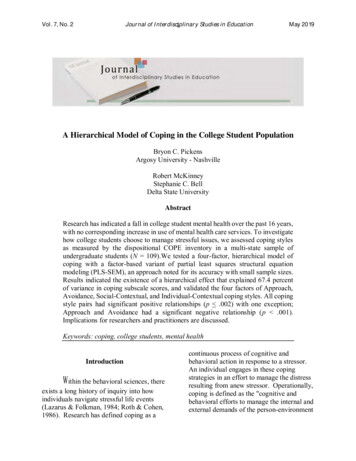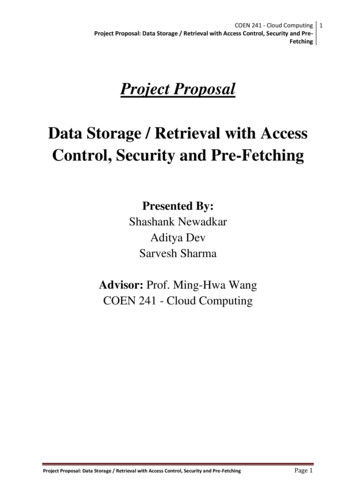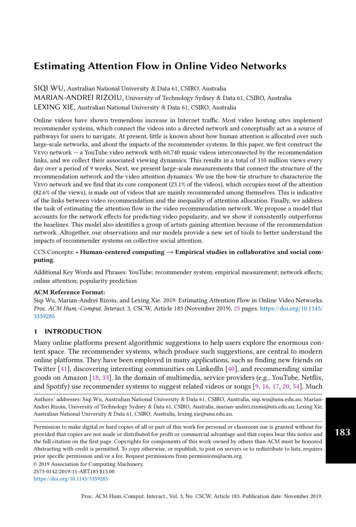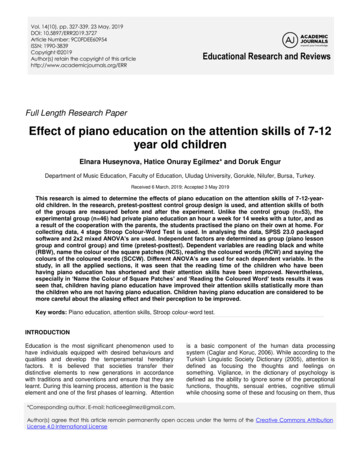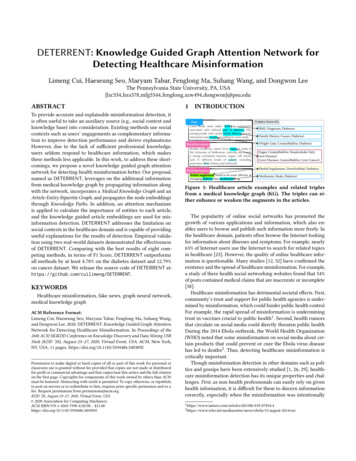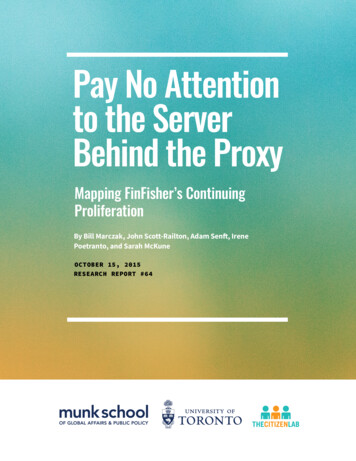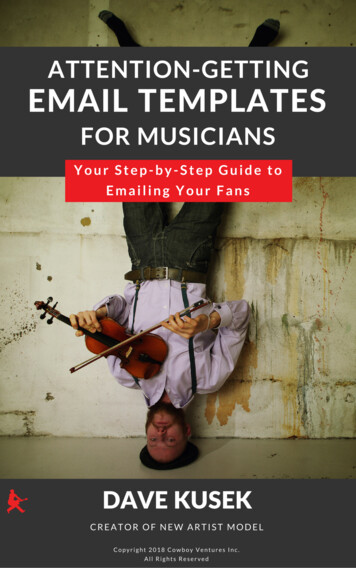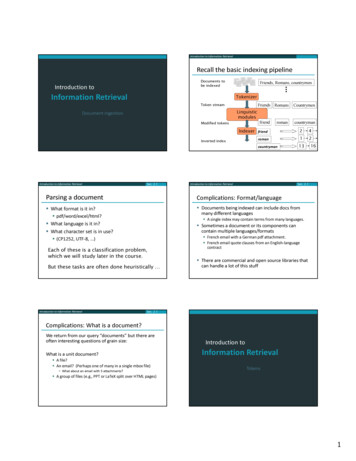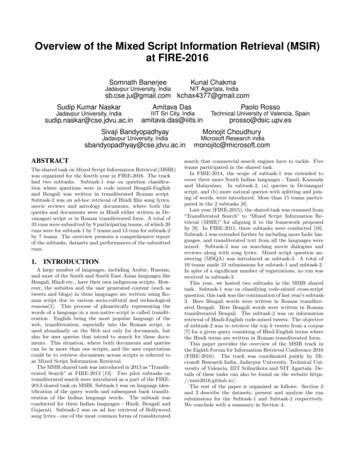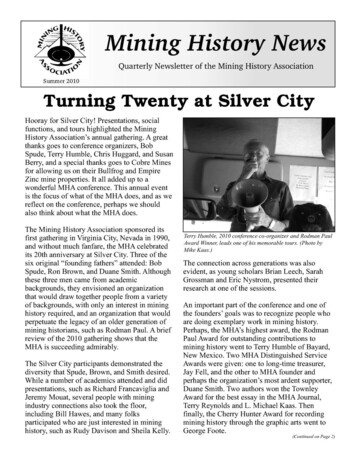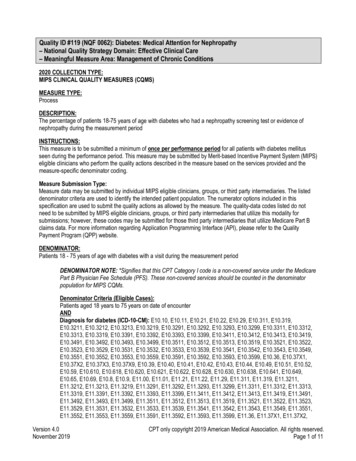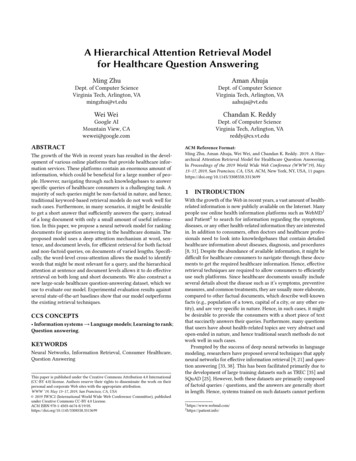
Transcription
A Hierarchical Attention Retrieval Modelfor Healthcare Question AnsweringMing ZhuAman AhujaDept. of Computer ScienceVirginia Tech, Arlington, VAmingzhu@vt.eduDept. of Computer ScienceVirginia Tech, Arlington, VAaahuja@vt.eduWei WeiChandan K. ReddyGoogle AIMountain View, CAwewei@google.comDept. of Computer ScienceVirginia Tech, Arlington, VAreddy@cs.vt.eduABSTRACTThe growth of the Web in recent years has resulted in the development of various online platforms that provide healthcare information services. These platforms contain an enormous amount ofinformation, which could be beneficial for a large number of people. However, navigating through such knowledgebases to answerspecific queries of healthcare consumers is a challenging task. Amajority of such queries might be non-factoid in nature, and hence,traditional keyword-based retrieval models do not work well forsuch cases. Furthermore, in many scenarios, it might be desirableto get a short answer that sufficiently answers the query, insteadof a long document with only a small amount of useful information. In this paper, we propose a neural network model for rankingdocuments for question answering in the healthcare domain. Theproposed model uses a deep attention mechanism at word, sentence, and document levels, for efficient retrieval for both factoidand non-factoid queries, on documents of varied lengths. Specifically, the word-level cross-attention allows the model to identifywords that might be most relevant for a query, and the hierarchicalattention at sentence and document levels allows it to do effectiveretrieval on both long and short documents. We also construct anew large-scale healthcare question-answering dataset, which weuse to evaluate our model. Experimental evaluation results againstseveral state-of-the-art baselines show that our model outperformsthe existing retrieval techniques.CCS CONCEPTS Information systems Language models; Learning to rank;Question answering.KEYWORDSNeural Networks, Information Retrieval, Consumer Healthcare,Question AnsweringThis paper is published under the Creative Commons Attribution 4.0 International(CC-BY 4.0) license. Authors reserve their rights to disseminate the work on theirpersonal and corporate Web sites with the appropriate attribution.WWW ’19, May 13–17, 2019, San Francisco, CA, USA 2019 IW3C2 (International World Wide Web Conference Committee), publishedunder Creative Commons CC-BY 4.0 License.ACM ISBN 08558.3313699ACM Reference Format:Ming Zhu, Aman Ahuja, Wei Wei, and Chandan K. Reddy. 2019. A Hierarchical Attention Retrieval Model for Healthcare Question Answering.In Proceedings of the 2019 World Wide Web Conference (WWW’19), May13–17, 2019, San Francisco, CA, USA. ACM, New York, NY, USA, 11 ODUCTIONWith the growth of the Web in recent years, a vast amount of healthrelated information is now publicly available on the Internet. Manypeople use online health information platforms such as WebMD1and Patient2 to search for information regarding the symptoms,diseases, or any other health-related information they are interestedin. In addition to consumers, often doctors and healthcare professionals need to look into knowledgebases that contain detailedhealthcare information about diseases, diagnosis, and procedures[8, 31]. Despite the abundance of available information, it might bedifficult for healthcare consumers to navigate through these documents to get the required healthcare information. Hence, effectiveretrieval techniques are required to allow consumers to efficientlyuse such platforms. Since healthcare documents usually includeseveral details about the disease such as it’s symptoms, preventivemeasures, and common treatments, they are usually more elaborate,compared to other factual documents, which describe well-knownfacts (e.g., population of a town, capital of a city, or any other entity), and are very specific in nature. Hence, in such cases, it mightbe desirable to provide the consumers with a short piece of textthat succinctly answers their queries. Furthermore, many questionsthat users have about health-related topics are very abstract andopen-ended in nature, and hence traditional search methods do notwork well in such cases.Prompted by the success of deep neural networks in languagemodeling, researchers have proposed several techniques that applyneural networks for effective information retrieval [9, 21] and question answering [33, 38]. This has been facilitated primarily due tothe development of large training datasets such as TREC [35] andSQuAD [25]. However, both these datasets are primarily composedof factoid queries / questions, and the answers are generally shortin length. Hence, systems trained on such datasets cannot perform1 https://www.webmd.com/2 https://patient.info/
What would happen if I didn’t take antithyroidmedicines?It is usually advisable to treat an overactivethyroid gland (hyperthyroidism). Untreated hyperthyroidism can cause significant problemswith your heart and other organs. It may alsoincrease your risk of complications should youbecome pregnant. However, in many cases thereare other treatment options. That is, radioactiveiodine or surgery may be suitable options. Seethe separate leaflet called Overactive ThyroidGland (Hyperthyroidism) for details of theseother treatment options .Figure 1: An example of a healthcare question, and it’s corresponding answer. The question and answer do not have anyoverlapping words. The highlighted text corresponds to themost relevant answer snippet from the document.well in a setting where a large proportion of the queries are nonfactoid and open-ended, and the documents are relatively longerin length. Figure 1 shows an example of a typical question that aconsumer would have regarding antithyroid medicines, and it’scorresponding answer paragraph, selected from the website Patient.This problem and the domain provides some unique challengeswhich require us to build a more comprehensive retrieval system. Minimal overlap between question and answer words: Thereis minimal or no word overlap between the question and answertext. As there are no matching terms, traditional keyword-basedsearch mechanisms will not work for answering such questions. Length of question and answer: The question is longer thana typical search engine query. The answer is also typically longerthan a sentence. Although, for illustration purposes, we showa short paragraph, in many cases, the answer, as well as thedocument containing it, might be even longer. Hence, neuralsemantic matching algorithms will not be effective in such cases,as they are ideally designed for short sentences. Therefore, aneffective retrieval system would require a mechanism to dealwith documents of varied lengths. Non-factoid nature: The question is very open-ended in nature, and does not ask for any specific factual details. As such, amajority of the machine comprehension models are trained ondatasets like SQuAD, which are comprised of factoid QA pairs.Such systems do not work well in a setting where the desiredanswer is more elaborate.To overcome these problems, we propose HAR, a HierarchicalAttention Retrieval model for retrieving documents for healthcarerelated queries. The proposed model uses a cross-attention mechanism between the query and document words to discover the mostimportant words that are required to sufficiently answer the query.It then uses a hierarchical inner attention, first over different wordsin a sentence, and then over different sentences in a document, tosuccessively select the document features that might be most relevant for answering the query. Finally, it computes a similarity scoreof a document with the query, that could be used to rank differentdocuments in the corpus, given a query. The use of hierarchicalattention also enables it to find the most important sentences andwords, that could be important to answer a query, without the needof using an explicit machine comprehension module. To evaluatethe performance of our model, we construct a large scale healthcare question answering dataset, using knowledge articles collectedfrom the popular health services website Patient. Although we usethis model in the healthcare domain, where the questions are usually non-factoid in nature, and the documents are longer due to thepresence of detailed description about different medical procedures,our model is more generic, and can be used in any domain wherethe questions are open-ended, and the documents are longer.The rest of this paper is organized as follows: Section 2 gives anoverview of the existing techniques related to our work. In Section3, we describe our proposed neural retrieval model called HAR, andprovide the details about its architecture and the training procedure,including the optimization for the HAR model. The details aboutthe data collection and annotation have been described in Section 4.In Section 5, we give details about our experimental evaluation, andthe metrics and baseline techniques used in the evaluation process.Finally, Section 6 concludes the paper, with possible directions forfuture research.2 RELATED WORK2.1 Document RankingDocument retrieval and ranking is a classical problem in the information retrieval community, which has attracted significant interestfrom researchers for many years. Early methods in informationalretrieval were largely based on keyword-based query-documentmatching [27, 29, 30]. With the advancement of machine learningalgorithms, better retrieval mechanisms have been proposed. Logistic Inference [7] used logistic regression probabilities to determinethe relevance between queries and documents. In [14], the authorsused Support Vector Machine (SVM) based approach for retrieval,which allows the retrieval system to be trained using the search engine click logs. Other traditional techniques in information retrievalinclude boosting-based methods [6, 41]. TF-IDF based similarity[26] and Okapi BM25 [28] are the most popularly used term-basedtechniques for document search and ranking. However, such techniques usually do not perform well, when the documents are longer[18], or have minimal exact word overlap with the query.2.2Neural Information RetrievalWith the success of deep neural networks in learning feature representation of text data, several neural ranking architectures havebeen proposed for text document search. Deep Structured SemanticModel (DSSM) [13] uses a simple feed-forward network to learnthe semantic representation of queries and documents. It then computes the similarity between their semantic representations usingcosine similarity. Convolutional Deep Structured Semantic Model(CDSSM) [34] uses convolutional layers on word trigram features,while the model proposed in [22] uses the last state outputs ofLSTM encoders as the query and document features. Both thesemodels then use cosine similarity between query and documentrepresentations, to compute their relevance. In [12], the authors
propose convolutional neural network models for semantic matching of documents. The Architecture-I (ARC-I) model proposed inthis work also uses a convolutional architecture to create documentlevel representation of query and document, and then uses a feedforward network to compute their relevance. The InferSent Ranker[11] proposed recently also uses a feed forward network to compute the relevance between query and documents, by summingup their sentence embeddings. However, all these methods use thedocument-level semantic representation of queries and documents,which is basically a pooled representation of the words in the document. However, in majority of the cases in document retrieval, it isobserved that the relevant text for a query is very short piece of textfrom the document. Hence, matching the pooled representationof the entire document with that of the query does not give verygood results, as the representation also contains features from otherirrelevant parts of the document.To overcome the problems of document-level semantic-matchingbased IR models, several interaction-based IR models have been proposed recently. In [9], the authors propose Deep Relevance Matching Model (DRMM), that uses word count based interaction features between query and document words, while the Architecture-II(ARC-II) proposed in [12] uses convolution operation to computethe interaction features. These features are then fed to a deep feedforward network for computing the relevance score. The modelsproposed in [4, 40] use kernel pooling on interaction features tocompute similarity scores, while MatchPyramid [23] uses the dotproduct between query and document word vectors as their interaction features, followed by convolutional layers to compute therelevance score. Other methods that use word-level interaction features are attention-based Neural Matching Model (aNMM) [42], thatuses attention over word embeddings, and [36], that uses cosineor bilinear operation over Bi-LSTM features, to compute the interaction features. The Duet model proposed in [21] combines bothword-level interaction features, as well as document-level semanticfeatures, in a deep CNN architecture, to compute the relevance. Onecommon limitation of all these models is that they do not utilizethe inherent paragraph and sentence level hierarchy in documents,and hence, they do not perform well in case of longer documents.By using a powerful cross attention mechanism between queryand document words, our model can effectively determine the mostrelevant document words for a query. It then uses hierarchical innerattention over these features, which enables it to effectively dealwith long documents. This is especially helpful in cases where therelevant information in the document is a very small piece of text.Hence, medical retrieval needs to be accurate, and should preciselyserve the requirements of the use
documents for question answering in the healthcare domain. The proposed model uses a deep attention mechanism at word, sen-tence, and document levels, for efficient retrieval for both factoid and non-factoid queries, on documents of varied lengths. Specifi-cally, the word-level cross-attention allows the model to identify words that might be most relevant for a query, and the hierarchical .
